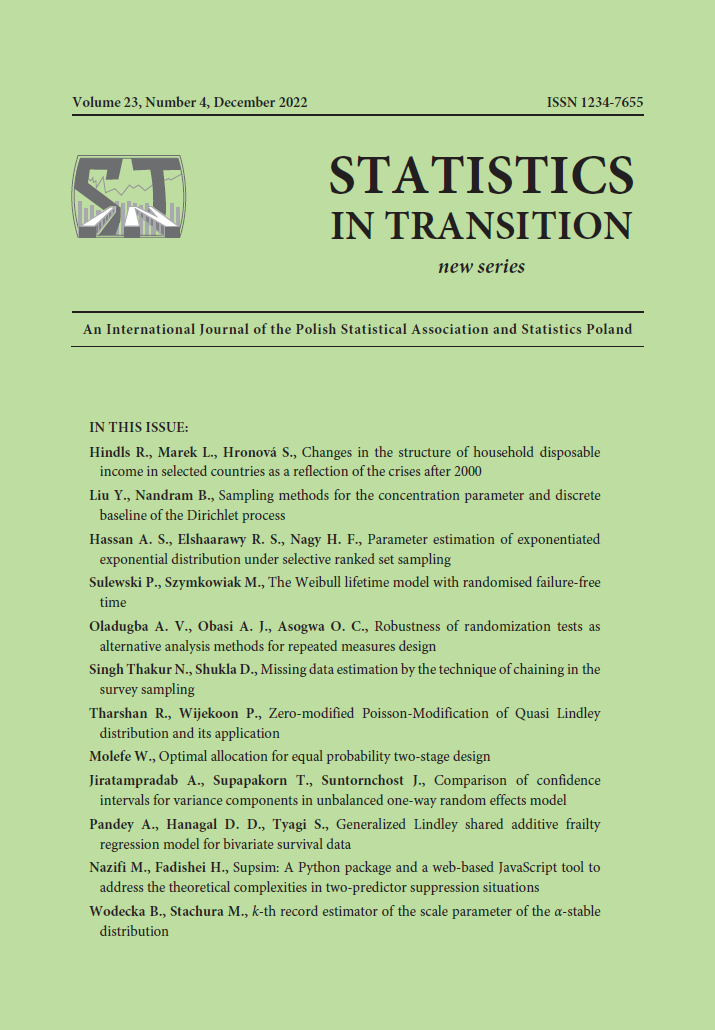ARTICLE
ABSTRACT
The Poisson-Modification of Quasi Lindley (PMQL) distribution is a newly introduced mixed Poisson distribution for over-dispersed count data. The aim of this article is to introduce the Zero-modified PMQL (ZMPMQL) distribution as an alternative to the PMQL distribution in order to accommodate zero inflation/deflation. The method of obtaining the ZMPMQL distribution jointly with some of its important properties, namely the probability mass and distribution functions, mean, variance, index of dispersion, and quantile function are presented. Furthermore, some of its special cases are discussed. The maximum likelihood (ML) estimation method is used for the unknown parameter estimation. A simulation study is conducted in order to evaluate the asymptotic theory of the ML estimation method and to show the superiority of the ML method over the method of moments estimation. The applicability of the introduced distribution is illustrated by using a real-world data set.
KEYWORDS
over-dispersion, mixed Poisson distribution, PMQL distribution, zero modification, maximum likelihood estimation
REFERENCES
Albrecht, P., (1984). Laplace Transforms, Mellin Transforms and Mixed Poisson Processes. Scandinavian Actuarial Journal, 11, pp. 58–64.
Da Silva, W. B., Ribeiro, A. M. T., Conceicao, K. S., Andrade, M. G., Neto, F. L., (2018). On Zero-Modified Poisson-Sujatha Distribution to Model Overdispersed Count Data. Austrian Journal of Statistics, 47(3), pp. 1–19.
Ghitany, M.E., Atieh, B., Nadarajah, S., (2008). Zero-truncated Poisson-Lindley Distribution and Its Application. Mathematics and Computers in Simulation, 79, pp. 279–287. https://doi.org/10.1016/j.matcom.2007.11.021.
Greenwood, M., Yule, G. U., (1920). An inquiry into the nature of frequency distributions representative of multiple happenings with particular reference to the occurrence of multiple attacks of disease or of repeated accidents. Journal of the Royal Statistical Society, 83, pp. 255–279. doi: 10.2307/2341080.
Grine, R., Zeghdoudi, H., (2017). On Poisson quasi-Lindley distribution and its applications. J. of Modern Applied Statistical Methods, 16, pp. 403–417.
Irwin, J., (1975). The Generalized Waring Distribution Parts I, II, III. Journal of the Royal Statistical Society A, 138, 18–31 (Part I), pp. 204–227 (Part II), pp. 374–384 (Part III). doi:10.2307/2345247.
Lindsey, J. K., (1995). Modelling Frequency and Count Data, Oxford science publications, Clarendon Press, UK.
R Core Team (2020). R: A language and environment for statistical computing. R Foundation for Statistical Computing, Vienna, Austria. https://www.R-project.org/.
Sankaran, M., (1970). The discrete Poisson-Lindley distribution. Biometrics, 26, pp. 145– 149. doi:10.2307/2529053.
Shanker, R., (2016b). Sujatha Distribution and Its Applications. Statistics in Transition New series, 17, pp. 1–20.
Shanker, R., (2016c). The Discrete Poisson-Sujatha Distribution. International Journal of Probability and Statistics, 5, pp. 1–9.
Tharshan, R.,Wijekoon, P., (2021). A modification of the Quasi Lindley distribution, Open Journal of Statistics, 11, 369–392. doi:10.4236/ojs.2021.113022.
Tharshan, R., Wijekoon, P., (2022). A New Mixed Poisson Distribution for Over-dispersed Count Data: Theory and Applications, Reliability: Theory and Applications, 17, pp. 3351, doi: https://doi.org/10.24412/1932-2321-2022-167-33-51.
Xavier, D., Santos-Neto, M., Bourguignon, M., Tomazella, V., (2018). Zero-Modified Poisson-Lindley distribution with applications in zero-inflated and zero-deflated count data, arXiv preprint. arXiv:1712.04088.
